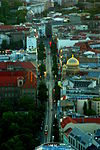Berlin Oranienburger Straße station
Berlin S-Bahn stationsBuildings and structures in MittePages with no open date in Infobox stationRailway stations in BerlinRailway stations in Germany opened in 1936 ... and 1 more
Railway stations located underground in Germany

Berlin Oranienburger Straße (in German Bahnhof Berlin Oranienburger Straße) is a railway station in the city of Berlin, Germany, located on Oranienburger Straße. It is served by the Berlin S-Bahn and local tram lines.
Excerpt from the Wikipedia article Berlin Oranienburger Straße station (License: CC BY-SA 3.0, Authors, Images).Berlin Oranienburger Straße station
Oranienburger Straße, Berlin Mitte
Geographical coordinates (GPS) Address Phone number Website Nearby Places Show on map
Geographical coordinates (GPS)
| Latitude | Longitude |
|---|---|
| N 52.525 ° | E 13.392777777778 ° |
Address
Lawrence Café Bar Restaurant
Oranienburger Straße 69
10117 Berlin, Mitte
Germany
Open on Google Maps










